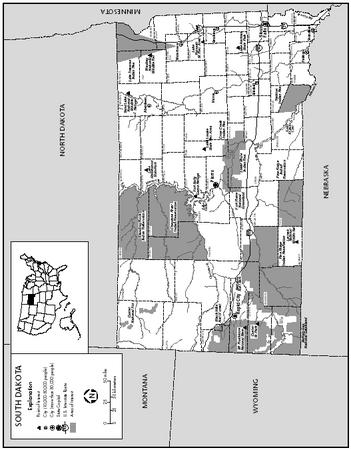South Dakota
History
People have lived in what is now South Dakota for at least 25,000 years. The original inhabitants, who hunted in the northern Great Plains until about 5000 BC, were the first of a succession of nomadic groups, followed by a society of semisedentary mound builders. After them came the prehistoric forebears of the modern riverine groups-Mandan, Hidatsa, and Arikara-who were found gathering, hunting, farming, and fishing along the upper Missouri River by the first European immigrants. These groups faced no challenge until the Sioux, driven from the Minnesota woodlands, began to move westward during the second quarter of the 18th century, expelling all other Native American groups form South Dakota by the mid-1830s.
Significant European penetration of South Dakota followed the Lewis and Clark expedition of 1804–06. White men came to

The Dakota Territory, which included much of present-day Wyoming and Montana as well as North and south Dakota, was established in 1861, with headquarters first at Yankton (1861–83) and later at Bismarck (1883–89). The territory was reduced to just the Dakotas in 1868; six years later, a gold rush brought thousands of prospectors and settlers to the Black Hills. South Dakota emerged as a state in 1889, with the capital in Pierre. Included within the state were nine Indian reservations, established, after protracted negotiations and three wars with the Sioux, by Indian Office personnel. Five reservations were established west of the Missouri for the Teton and Yanktonai Sioux, and four reserves east of the Missouri for the Yankton and several Isanti Sioux tribes. Sovereignty was thus divided among Indian agents, state officials, and tribal leaders, a division that did not always make for efficient government. Through the late 19th and early 20th centuries, South Dakotans had limited economic opportunities, for they depended mainly on agriculture. Some 30,000 Sioux barely survived on farming and livestock production, supplemented by irregular government jobs and off-reservation employment. The 500,000 non-Indians lived mainly off cattle-feeding enterprises and small grain sales east of the Missouri, mineral production (especially gold) in the Black Hills, and various service industries at urban centers throughout South Dakota.
The period after World War I saw extensive road building, the establishment of a tourist industry, and efforts to subdue and harness the waters of the Missouri. Like other Americans, South Dakotans were helped through the drought and depression of the 1930s by federal aid. Non-Indians were assisted by food relief, various work-relief programs, and crop-marketing plans, while Indians enjoyed an array of federal programs often called the "Indian New Deal." The economic revival brought about by World War II persisted into the postwar era. Rural whites benefited from the mechanization of agriculture, dam construction along the Missouri, rural electrification, and arid-land reclamation. Federal programs were organized for reservation Indians, relocating them in urban centers where industrial jobs were available, establishing light industries in areas already heavily populated by Indians, and improving education and occupational opportunities on reservations.
Meanwhile, the Sioux continued to bring their historic grievances to public attention. For 70 days in 1973, some 200 armed Indians occupied Wounded Knee, on the Pine Ridge Reservation, where hundreds of Sioux had been killed by US cavalry 83 years earlier. In 1980, reviewing one of several land claims brought by the Sioux, the US Supreme Court upheld compensation of $105 million for land in the Black Hills taken from the Indians by the federal government in 1877. But members of the American Indian Movement (AIM) opposed this settlement and demanded the return of the Black Hills to the Sioux. The economic plight of South Dakota's Indians worsened during the 1980s after the federal government reduced job training programs, and conditions on reservations remained bad in the 1990s, with unemployment in some cases as high as 70%.
In sharp contrast, the state economy as a whole showed strength under the direction of Republican Governor William Janklow, elected in 1978 and reelected in 1982 and, after an eight-year hiatus, in 1994. Janklow, noted for his strong opposition to Indian claims, developed the state's water resources, revived railroad transportation, and attracted new industry to South Dakota, including Citicorp, the largest bank-holding company in the US, which set up a credit-card operation in Sioux Falls and bought controlling interest in the American State Bank of Rapid City. In the 1990s, farm income had risen; record corn and soybean yields were reported in 1994, in spite of major flooding the year before that resulted in parts of the state being declared disaster areas. Manufacturing also prospered, expanding by up to 10% each year in the early 1990s. Legalized casino gambling has become an important source of government revenue since it was authorized in 1989.
Although the state had budget problems in 2003, they were not as severe as other states. Republican Governor Mike Rounds, elected in 2002, asked legislators in 2003 to increase state aid to schools by $15 million and to create a prescription drug program. He planned a full-scale review of the state department of education.
In 2003 South Dakota was experiencing severe drought conditions once again, after a damaging drought in 2002 ruined crops, kept grass from growing, and led ranchers to sell off their cattle.